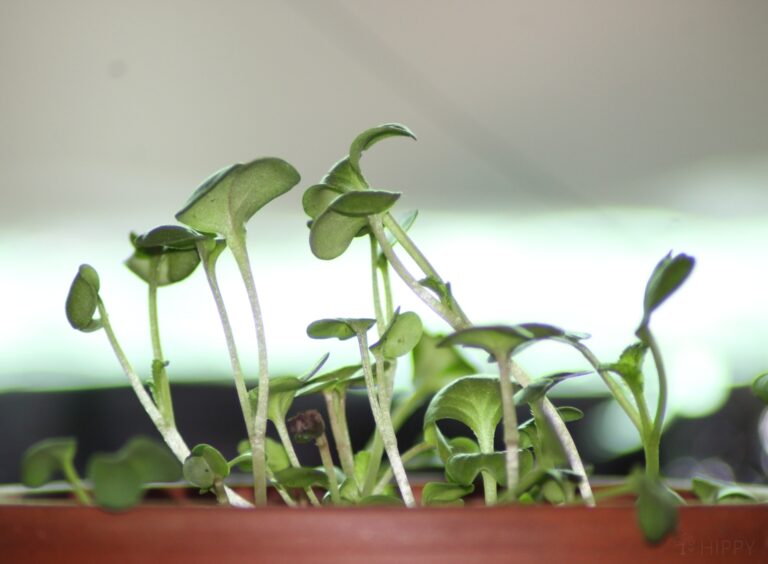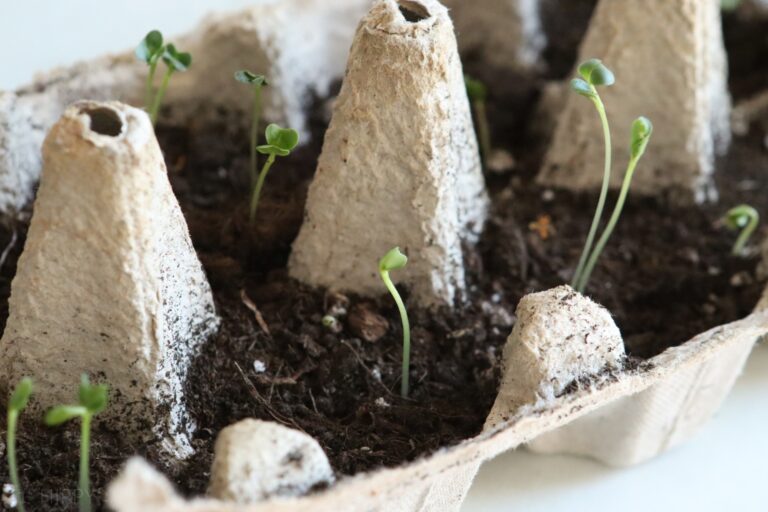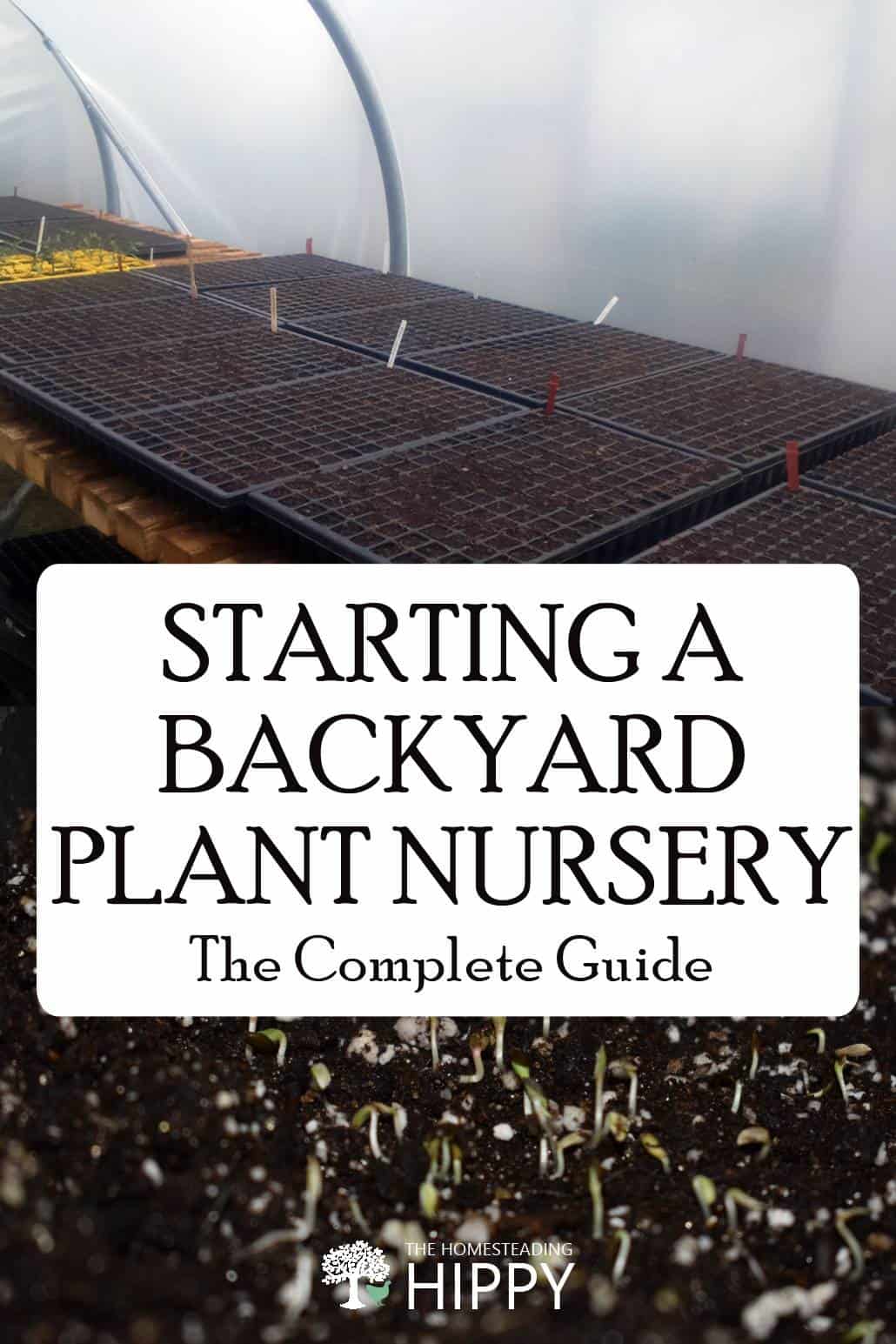If you’re good with plants and want to make a little money on the side, you might want to start your own backyard plant nursery.
You don’t need a lot of space or money to get started; you just need a little bit of yard, a little knowledge of plant propagation, and some plants.

Starting your backyard nursery can be as simple as selling off your extra seedlings at a garage sale.
Over time, you can grow your small nursery business into something as complex as renting land, greenhouses, and equipment, should you desire to do so. One of the benefits of a backyard nursery is how very little you actually need to get started.
To start your nursery, you’ll need to make a plan, do your research, so you can market, advertise, grow, and sell your plants.
With the right information, you’ll be able to easily select which plants to grow in your location and reach potential customers. In this article, we’ll give you an overview of how you can get your plant nursery started quickly and easily.
Table of Contents
What is a Plant Nursery?
A plant nursery is a great place to get your lawn and garden started. It’s like a one-stop shop for all sorts of plants, trees, shrubs, flowers and herbs – basically anything you can imagine that grows out of the ground.
In a plant nursery, you can make good money by selling any kind of plants you want – perennials and annuals alike. You could sell edible plants, trees like towering maple trees, or even tropical plants!
Other popular plants to include in your nursery include ornamental grasses, bulbs, herbs (like oregano), or even high-value plants like orchids and bromeliads. The sky’s the limit!
What is the Difference Between a Nursery and Garden Center?
A nursery and garden center offer a range of items for the avid gardener, but there are a few key distinctions between the two…
A nursery specializes exclusively in plants, whether outdoor or indoor, flowering or foliage, trees or shrubs.
Garden centers offer essentially everything that a nursery does in addition to other gardening supplies, such as tools, equipment, soil amendments, mulch and pottery.
Furthermore, garden centers may have greenhouses where they can cultivate their own stock of plants – something that nurseries typically do not provide.
Together these two types of businesses serve an important role in helping gardeners achieve the look they desire: nurseries as suppliers of living botanical materials, and garden centers as suppliers of all the other components necessary to turn a yard into a thriving oasis.
However, for most people who are reading this article, starting a backyard nursery is a much easier endeavor than starting a garden center!
What Are the Advantages from Plant Nurseries?
For those looking to add greenery and beauty to their backyard, one of the best ways is to set up and start a backyard plant nursery.
As opposed to buying plants from a store or ordering them online and waiting for delivery, having your own nursery allows you the ability to easily access the plants immediately and begin planting when needed or desired.
Not only does this provide convenience, but it’s also an easy and economical way for anyone to participate in growing their own plants. By growing and producing your own plants at home, you can also guarantee a personal touch.
You’ll be able to grow the exact types of plants you want for your own unique garden…
For example, if there are hybrid or rare plants you want to try that are difficult to find in your local area, you can cultivate your own right at home so you can ensure the varieties you want to grow are always accessible.
And since these plants are under your watchful eye, you can mitigate any issues that might come up with pests quickly following them from other nurseries from home.
You’ll be able to source all your own plants so you won’t have to worry about trucking in potential problems by buying them elsewhere.
Let’s not forget that growing your own plants is a great way to save on trucking – meaning you’ll be practicing greater environmental sustainability too!
Make a Plan
You’re going to need some kind of a plan to get started.
You can purchase books on Amazon with free business plans included, or you can make your own business plan, but if you start growing a bunch of plants without knowing how you will get customers and sell those plants, your business is more likely to fail.
If you need help, your local account can give you an idea of what you need to do to get started. Better yet, find a local farmer to be your mentor. You can always tweak your plan as you discover what works and what doesn’t work.
When Should You Start Building a Nursery?
If you are looking to start a plant nursery, the best time of year to begin is in the late spring. This is because this is the time when plants will be ready for transplanting, and young seedlings can be harvested for sale.
It also helps if nurseries are set up before summer headsets in, as many plants are sensitive to extreme temperatures and may not thrive during hot spells.
In addition, planting during this time of year allows for the maximum amount of growing season before the winter cold sets in.
Do your Research
If you are going to start your own backyard plant nursery, you need to do a little research first. Ask yourself the following questions, and if you don’t know how to answer these questions, you may want to contact your local agricultural extension to get started.
What grows where you live?
The first thing you need to know is, What grows where you live.
If you live in the desert, you won’t do very well selling garden plants meant for more tropical areas, and if you live in an area that gets snow, you certainly won’t have much success selling plants intended for the desert. Here are a few things to consider:
- Your climate. Is it hot, wet, dry, cold, or more temperate? Do you have different seasons?
- Your grow zone. You need to know your grow zone so you can tell your customers when it is safe to plant outside. Also, if you are propagating your plants outdoors, you’ll need to know when it is safe to do so. You don’t want to lose your stock to a frost or dry spell. Learning your first and last frost dates will help you figure this out.
- When to sell which plants. For example, if you are going to be selling vegetables, you’ll want to do so at the beginning of your local planting season (this would be right before Mother’s Day in US Hardiness Zone 6b. You can find your US Hardiness Zone here. On the other hand, if you are selling houseplants, you could do that all year round.
What’s in demand?
What kinds of plants are people looking for? Are people in your neighborhood planting lots of landscaping plants, lots of veggies in the garden, or even fruit trees? What’s popular in your area? Is there a niche that needs to be filled?
Think not only of your love of plants specifically, but also what kind of ideal backyard nursery crop might fill the local need.
After all, if you’re going to be selling your nursery plants and not just growing them for yourself, you need to think about what people might actually want to buy (not just what you are interested in growing).
If you live in an area with water shortages, growing plants that have a high water consumption just doesn’t make sense. Similarly, if you live in an urban area, you’ll want to choose smaller plants that are ideal for confined areas like apartments.
If you need help determining what to grow, visit a few farmer’s markets, and see what kinds of plants they are selling. You might even find a helpful friend or mentor to give you tips.
What do you enjoy growing?
Is there a plant that you’re really crazy about? Do you love growing orchids? Or do you lean more towards vegetables? You’ll have an easier time growing and selling the plants that you love best.
What do you already have?
Do you have an abundance of tomato seedlings?
Perhaps you’ve been propagating succulents for no reason, and now you’re overrun with itty bitty plants. You may have great success with your raspberry bushes or propagating pussy willow trees.

If you have a stock of plants you can propagate, your starting costs will be even lower. If you’re successful with growing a plant you already have, you can help your potential customers be successful, too.
How do you propagate, grow, and sell the plants you plan on selling in your backyard nursery?
What do you need to know about the plants you have, and what do you need to tell your clients? Will you be using organic methods, or more traditional means of growing your plants? How will you package your plants for selling?
Try to find out everything you can about the plants you will be growing and selling. People will love it if you share your information freely and help them to grow their plants, too.
Do you need any special permits to grow, sell, or produce the plants in your backyard nursery? You need to check on your state and local laws before you get started. Do you have an HOA that limits home businesses or gardening?
Do you need to register as an LLC? Do you need a permit or license to operate a backyard nursery or to sell specific plants from it? A quick phone call to your HOA, your local AG extension, and your township offices could save you lots of fines in the long run.
Start Small
You don’t need to invest thousands of dollars in starting a small backyard nursery. If you have access to supplies already, you might not need to invest anything at all.
Suppose you simply sell off your spare vegetable seedlings and extra plants using newsprint pots and dirt from your yard. In that case, you’ll be able to generate some income that you could invest into growing your business for the following season.
If you start too large, you could easily be overwhelmed by the work that needs to be done. And if you don’t have customers to buy your plants, then you’ll have wasted your hard work and investment.
Gather Your Supplies
You will need a few supplies to get started, but they don’t have to cost you a small fortune. At the very least, you will need:
- Pots
- Soil
- Plants or Seeds
- Space to grow
Where to Find Pots
You don’t need fancy planters for your backyard nursery plants. You could purchase a bulk pack of Red Solo cups.
These are a perfect size for starting vegetables, easy to find, and don’t take up a lot of storage space. Jess, from Roots and Refuge Farm, has an entire video on starting tomato seedlings in Solo Cups.
If you want actual nursery pots, you can purchase them in bulk from Amazon or even online through nursery suppliers. However, with a bit of effort, you might be able to find them for free.
Look for local nurseries that are closing or find big box stores that are throwing away dying plants at the end of the season. You might be able to rescue their pots from the dumpster, free of charge.
Check out Facebook Marketplace and Craigslist for yard sale pots, leftover pots, and don’t forget to ask your friends to give you their plastic containers after they’ve finished up their spring and fall planting.
You might want to clean them in a bleach solution to kill any fungi or bacteria that might destroy your seedlings. Make sure you rinse the pots well.
If you are crafty, you can create your own biodegradable pots from leftover newspapers. Creating your own pots would be a great way to reduce newspaper waste.
The plants can be planted in the ground right in the newsprint pots. This prevents the roots from being disturbed.
Where to Find Soil
Purchasing soil can be expensive, especially if you need a lot of it. You might want to consider using soil from your own yard, if appropriate.
You can use dirt from your yard as a base and add soil amendments such as compost. You could also order topsoil by the truckload and add in things such as perlite and worm castings to make it meet the needs of your plants.
Where to Find Plants and Seeds
There are plenty of places to purchase seeds and plants to propagate. You can find seeds anywhere from Amazon, The Dollar Store, your local big-box store, or in other places online. If you are looking for specialty plants, you may want to consider ordering them from specialized nurseries or eBay.
Purchasing specialized plants may require a small initial investment, but if you know-how and can propagate these plants, they will eventually pay for themselves.
Space to Grow
You need some kind of space to grow your plants and seedlings. This space could be a spare room in your house (especially if you are growing house plants), a corner of your garden, a spot in your greenhouse, or just a part of your yard.
If you don’t have a greenhouse, but you need one, you might consider putting up a hoop house. These temporary greenhouses can often be assembled without a special permit. They can be as small as a raised bed or as large as you like, depending on your need.
Start Growing
Once you have done all the legwork and have your supplies, it’s time to start growing. But what are you going to grow? If you aren’t sure what to grow, what about some of these ideas?
Landscaping plants:
- Groundcovers
- Potted bushes or trees
- Specialty roses
- Perennial grasses (like pampas grass)
- Perennials like azaleas or hydrangeas
Vegetables:
- Tomato seedlings
- Squash starts
- Container lettuce
- Herbs such as mint, thyme, or basil
- Berry bushes
Houseplants and Ornamentals:
- Spider plants
- Orchids
- Succulents and cacti
- Bamboo
- Bonsai
Landscaping Trees (Both Smaller and Larger Trees):
- Japanese maples
- Nut trees
- Balsams
Another idea for growing plants is to find a niche market that appeals to you.
For example, you might love coffee, so selling dwarf coffee trees that can be grown indoors as a houseplant might be something you could enjoy. You could even specialize in cacti for rock gardens!
Or perhaps you prefer fruit trees or flowering trees. On the one hand, a niche market might be an avenue to sell something that no one else has. But on the other hand, it might be hard to find enough customers if your niche is too small.
If you are going to sell a variety of plants, you might find it easiest to choose plants that all require similar care. If all of the plants you sell have the same watering and fertilizing needs, it will be easier for you to care for your stock.
Lastly, another consideration when choosing what to sell is the value of your plants. If you are selling $1 seedlings, you’ll have to sell a lot of them to make an income. But if you sell plants that are unique and rare, their value will be more.
You may want to choose higher-value plants to sell if you’re going to make a serious income from your backyard nursery.
Plant Care
You need to be an expert in the care of the plants you are going to sell. You’ll need to know what soil they need, their watering and fertilizing needs, and how much light they need.
You’ll also need to be able to provide this care for your plants. If you don’t give them enough water, for example, your plants will die, and your paycheck will die along with them.
Pest control is another thing to consider. How will you keep pests from eating your seedlings? Will you use organic methods of pest control, or will you use traditional pesticides and herbicides?
If you are growing plants inside your home or greenhouse, you’ll need to harden them off before they are ready to plant outside or teach your customers how to get them ready for outdoor planting.
The Backyard Nursery Business Side of Things
There are a few things you’ll need to take care of in regards to business as well.
Depending on the size and scope of your new business, you may need to purchase a business license and liability insurance (these may be options for beginners, but once you start selling a large quantity of plants, they might be a good idea).
Here are a few other things you’ll want to have buttoned up if you want to earn a good income running your new full time business:
Marketing
Marketing and advertising can get expensive fast, but it doesn’t have to be. Your marketing could be as simple as putting up a sign at the end of your driveway and having your friends tell others. Word of mouth is usually the best advertisement out there!
Sell!
You aren’t going to make any more if you don’t sell your plants somewhere. Here are a few ideas of where to sell your plants.
- Etsy. Etsy is a great choice for selling specialty items or seeds that you have collected.
- eBay. You can find many rare and hard-to-find plant species for sale on eBay.
- Craigslist. If you’re selling on Craigslist, you can choose to deliver or meet up in a neutral location.
- Facebook Marketplace. Facebook marketplace is similar to Craigslist. You can select local pickup or ship.
- Farmer’s Markets. To sell at a Farmer’s market, you might have to pay to set up your table. You may also want a few items such as a portable table, umbrella or pop-up tent, cash box, and signage. However, farmer’s markets give you an excellent opportunity to interact with customers and potential customers. They’ll let you know what kinds of things they are looking for, giving you insight into the market.
- Flea Markets. Flea markets can be similar to farmer’s markets.
- Plant Clubs. If you specialize in fancy roses or some other rare plant, you might be able to go and speak at a plant club. The right club will let you set up a table and sell plants in exchange for speaking at their meeting. A plant club is a great place to meet would-be clients, as well.
- Wholesale to growers and garden centers. It might be a little bit more difficult to find wholesale clients, but they make the process easier. Once you land a wholesale client, you deliver the plants, and they’ll take it from there. Selling to wholesale clients cuts down on potting, selling, marketing, and other costs.
- Your own location. It might be fun to sell from your own place, but you’ll also have to consider things like insurance, hours of operation, staffing, and other administrative tasks.
Taxes and Records
You’ll need to report your income to the IRS, and depending on what you are selling, you may also need to collect sales tax. You’ll want to keep detailed records of what you sold, when, and for how much.
You may want to use a spreadsheet or ledger for this. Regardless, you might want to consult your local accountant for tax advice.
Expand when you are ready.
Once you have mastered your small backyard plant nursery, you may want to start expanding it. You could expand by growing and selling a larger volume of plants, selling more varieties of plants, or simply expanding your market.
Customer Care
If you want return customers, you’ll need to take great care of them, as well as your plants.
You’ll need some way to communicate plant care to your customers. You may want to give them your phone number or email address if they need any extra help and support or just have questions about their new plants.
And you’ll want to be sure that your return, exchange, or guarantee policies are clearly communicated in case your customers have a problem with their order.
Keeping your customers happy and providing them with great plants is the key to getting them to come back for more!
Plant Nursery FAQ
A tree nursery can be a great investment for many, from individuals to businesses. Not only will it provide a steady income, but also the satisfaction of providing an important service to the community – growing and selling quality trees and plants.
Owning a plant nursery can be an incredibly rewarding and profitable experience.
Depending on the size of the nursery and whether it is located in a rural or urban area, as well as the time and resources dedicated to marketing, profits can range anywhere from a few thousand dollars per year to over a million dollars annually.
Generally, you’ll want to aim for an average markup of around 50-100% on your product. This means every dollar you invested in growing and tending the product is returned with one to two extra dollars in profit.
First and foremost, you’ll need to analyze your local market to decide what types of plants would have the best demand.
You’ll also need to secure an appropriate space for your nursery, such as some outdoor land or an indoor greenhouse, depending on individual preferences and available resources.
A plant nursery can require much more than just soil and seeds to run properly.
In addition to basic tools and supplies like shovels, trowels, and rakes, nurseries often require several different materials to ensure flourishing plants, like greenhouses, mulch, netting or screens, and special pots.


Amanda is a homesteader and a Jesus-loving, mother of 6 toddlers. She’s raising lots of fancy chickens and goats on her small homestead (among other things). Find out more about the team here.

You cover nothing about pricing your plants to sell. Overlooking this, or miscalculating, usually determines whether you succeed or fail.